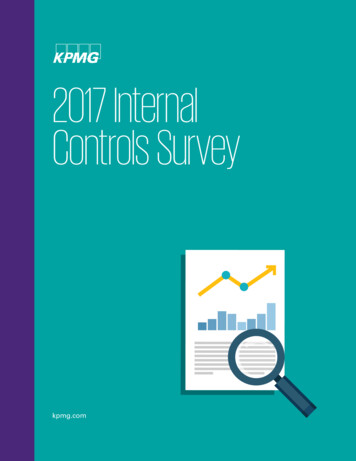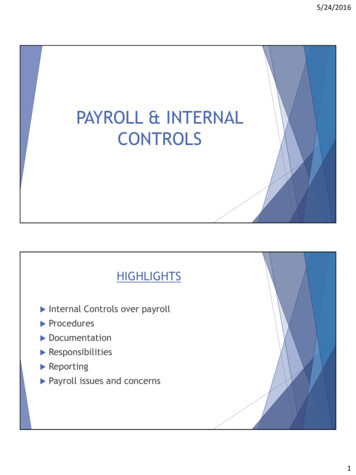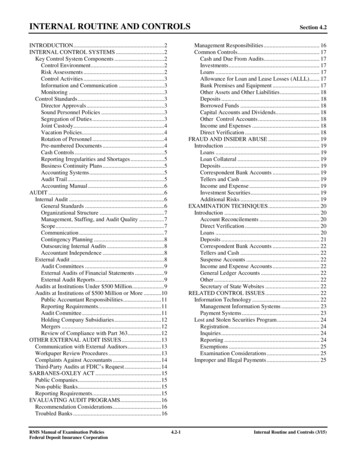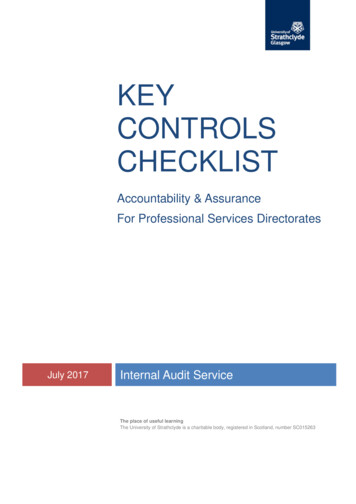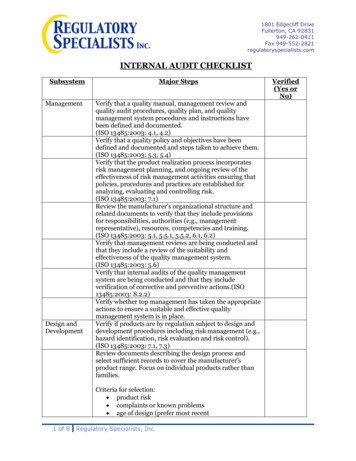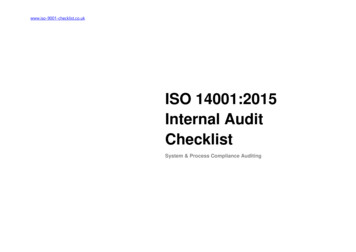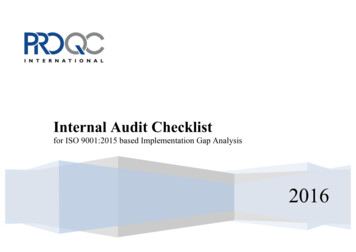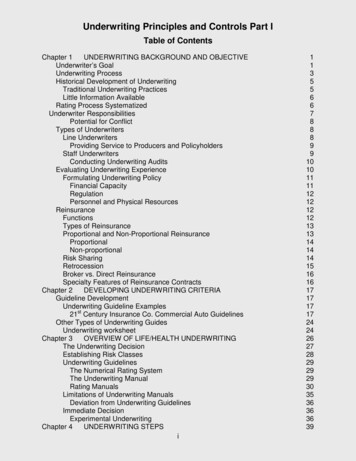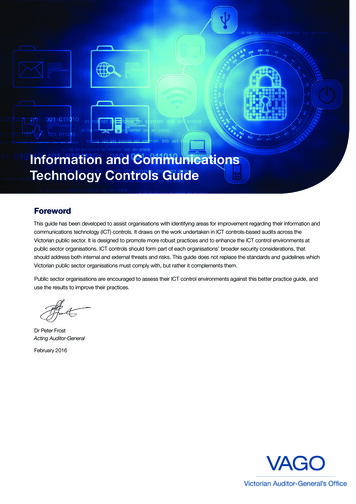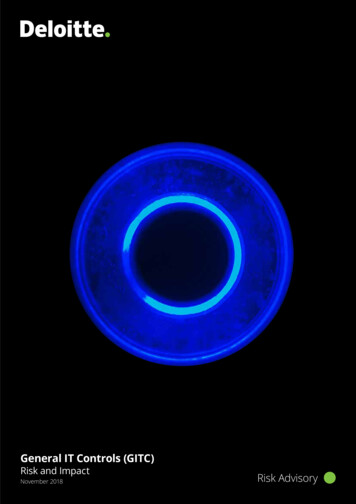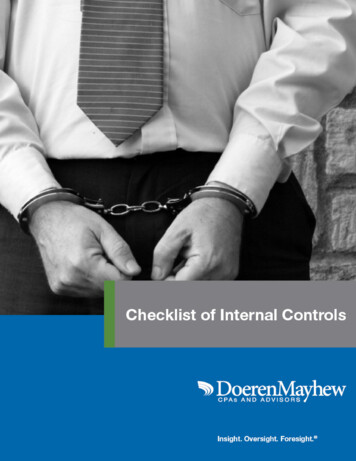
Transcription
Checklist of Internal ControlsThe typical organization loses an estimated 5 percent of annual revenue to fraudsters, according to a recentreport prepared by the Association of Certified Fraud Examiners (ACFE). Occupational fraud can be brokendown into three categories:Asset MisappropriationCorruptionFinancial Statement FraudSkimming, false invoicingor payroll fraudBribery,extortion andconflicts ofinterest“Cooking the books”To combat such activity, here is a checklist of the most common controls applied by small to medium-sizedbusinesses:Physical Assets Use physical security protection measures such as locks on premises, the use of security camerasand retaining a security service Keep smaller valuables in a safe Lock small but valuable items to desks Provide access codes to employees on a need-to-know basis Maintain an asset register with all relevant details of each asset Perform a regular asset-register audit Take out appropriate insurance coverage Review insurance coverage details regularlyIT Systems & Data Security Use passwords to limit access to business records Change computer passwords regularly Install firewalls, anti-virus software and other protective devices on computers Develop written policy guidelines on personal use of IT equipment2
Checklist of Internal ControlsFinancial Data Integrity Use sequentially numbered business forms (checks, orders, invoices, etc.) to provide an audit trail Perform reconciliation of accounts regularly Develop automated controls such as valid date ranges or dollar-value limits Implement budget and cash-flow projection reports and a regular comparison of budgeted againstactual figures and investigate any significant discrepancies Segregate the duties involved in financial transactions such as ordering, recording andpaying for purchases Institute supervisor-level review of financial records Build in validation checks to processes, for instance, checking invoice totals against the individualitems on the invoice to ensure accuracy Carry out exception routines such as spot checks or reviews Develop a hierarchy of spending-level approval authority Rotate duties involved in financial transactions and recording, i.e., petty cash and receipting Keep sufficient financial record details to provide useful management information, i.e.,double entry bookkeeping Keep books and records up to date and balanced Ensure employees with financial functions take their annual vacations Develop a records-retention scheduleSeparation of DutiesSmall and medium-sized businessor those experiencing a reductionin staff may feel they don’t havethe resources to achieve theseparation of duties necessary tohelp prevent internal theft, butprocedures can be developed tohelp companies of any sizeprotect themselves.The illustration at right offers oneexample of how even the smallestof offices can effectively separateduties:Office Manager/Bookkeeper Record A/R entries Mail checks Write checks Record general ledger entries Reconcile bank statements Approve payroll Receive cash Disburse peƩy cash Process vendor invoices Authorize purchase orders Authorize check requestsCEO or Owner/Manager Receive mail (open and disburse) Approve and sign checks Sign employee checks Complete deposit slips Perform interbank transfers Distribute payroll Reconcile peƩy cash Approve employee Ɵme sheets Authorize invoices for payment Have bank statement mailed toowner address Review bank reconciliaƟons andstatements Review all journal entries at monthend3
Checklist of Internal ControlsCompetent & Ethical Employees Develop a competency-based hiring policy Before you hire a new employee, perform a background check and require references Ensure new employees are adequately trained in routines and procedures Provide adequate employee supervision Implement a performance management system Provide clear job description and role responsibility documentation for employees Develop lines of communication with employees, i.e., suggestion boxes, team meetings, etc. Bond employees who deal with sensitive information Provide employees with a copy of the internal control system policy, explaining its value to thebusiness and the consequences of non-compliance Institute a confidentiality guaranteed employee feedback mechanismFraud FactsThe ACFE’s most recent surveyrevealed: Only 7% of those who commitfraud were previously convicted ofsuch an offense Behavioral red flags include anemployee living beyond his or hermeans (43% of victims surveyed)or experiencing financialdifficulties (36%) More than 80% of frauds occur inone of six departments:accounting, operations, sales,executive management, customerservice, purchasing Executive-level frauds often takelonger to detect4
Checklist of Internal ControlsPayroll Maintain security over payroll system passwords and change them regularly Review bank account deposits to ensure that each pay goes to a different bank account Separate payroll preparation, disbursement and distribution duties Check payroll-budgeted figure against payroll-actual figure and investigate variations Maintain accurate employee attendance records Reconcile salespersons’ commission records with their records of sales Maintain complete and accurate payroll records for holiday and sick-leave entitlements and leaveused Use direct bank deposits for pays Ensure that more than one person can process the payroll Separate the duties of personnel records management and payroll Develop and document a policy on allowable payroll deductions and who can authorize them Maintain security over attendance-recording systems Periodically review the payroll register against actual employeesSales Develop and document a pricing and discounting policy, including authorization to vary rules Check sales figures against their individual source, such as invoices If salespeople work on commission, ensure that their sales figures are valid Don’t pay commissions to salespeople until monies are received Reconcile sales register records with cash takings and credit card receipts Dispatch goods COD or with a copy of the invoice Require evidence of delivery Record orders on pre-numbered forms Compare sales invoices to shipping documents before dispatching Record sales invoices promptly Have customer complaints handled independently of the sales department5
Checklist of Internal ControlsAccounts Receivable Develop and document a credit approval/balance limit policy; include information on who mustauthorize new applications Conduct credit checks on new credit customers Review credit balances on a regular basis Develop an aged accounts procedure that includes regular reporting and follow-up Prepare trial balance of individual accounts receivable regularly Reconcile trial balances with general ledger control accounts Use numerical or batch processing controls over billing Record credit purchases as soon as the transaction occurs Keep the duties involved in accounts receivable separate from cash receipting Ensure mailing of accounts cannot be tampered with and separate mailing duties from statementpreparation duties Cross check early payment discounts and penalties on overdue accounts Have transactions such as non-cash credits and write-off of bad debts cross checkedAccounts Payable Develop and document a purchasing and accounts payable procedure, including authorization lev-els and any price comparison requirements prior to purchase Pay on original invoices only to avoid duplicate payment Mark paid invoices to prevent resubmission or double payment Set payment amount authorization permissions Separate the duties of supplier refund checks due from invoicing Check invoices from suspect sources e.g. businesses with only a post office box address Separate the duties of approving new suppliers from responsibility for payment of invoices Check the record of supplier billing each month and investigate any suspicious activity, i.e., in-creasing purchases from one vendor Carry out random checks of the invoices of individual suppliers Investigate invoices for poorly defined services, e.g. “listing the business in a directory” Develop a process that brings together the purchasing order and receiving reports, along with thecheck for payment, for review before signature Develop a procedure that ensures direct shipments to customers are properly billed to them6
Checklist of Internal ControlsReceipt of Goods Inspect goods for condition at time of receipt Check goods against order before approving payment Use pre-numbered receiving dockets Promptly pass invoices to accounts payable for payment Document a procedure for dealing with partial receipt andclaims for damaged goodsHandling Cash & Checks Keep checkbooks in secure storage Use pre-numbered checks Endorse checks “for deposit only” Enter check details in a way to prevent easy alteration Maintain a check register and review checks against it regularly,but at varying (unpredictable) intervals Mutilate voided checks before disposing of them Use a cash register to keep a record of cash sales Balance cash daily or more regularly according to the amount of cash handled Balance cash at the end of each shift where another employee is taking over transactions Post cash receipts to appropriate journals promptly Deposit cash receipts regularly to minimize the amount on hand Reconcile bank accounts monthly and give check-related duties to separate employees, i.e., rec-onciliation, check authorization, mail opening, writing deposit slips, banking Separate duties for cash disbursement and purchases from the approval process Conduct audits on a varying (unpredictable) schedule and do not warn employees of the date Impose a limit on the amount of petty cash held and the money value limit of petty cashpurchases Require that petty cash reimbursement requests be for pre-approved purchases only andsupported by approved types of documentation Keep petty cash in a secure repository Require a second signatory for petty cash disbursement Periodically have petty cash audited by a person separate from the person who pays it out7
The controls covered here apply to the processes mostbusinesses have in common – protecting physical assets,handling cash, etc. Naturally, each business will also haveits own industry-specific processes and regulations that itneeds to comply with, and each of these will need controls to address those areas as well.Doeren Mayhew can help develop and implement controls for your business, or perform an audit of your existing controls to identify areas of risk.Source: RAN ONE
Checklist of Internal Controls 3 Financial Data Integrity Use sequentially numbered business forms (checks, orders, invoices, etc.) to provide an audit trail Perform reconciliation of accounts regularly Develop automated controls such as valid date ranges or dollar-value limits Implement budget and cash-flow projection reports and a regular comparison of budgeted against
